Conversation 49: Understanding religious belief within the concept of the Directorate of Internalized Characters
Hello to our readers,
The evolution of religion in human society is a complex and multifaceted phenomenon that has been studied by researchers from various disciplines including anthropology, sociology, psychology and history. Although it is challenging to trace exact origins and trace a linear progression, there are a few key stages and developments that can be seen in the evolution of religion [Written with the help of the GPT CHAT after we checked and made many edits and additions to the text]:
1. Animism and Shamanism: Animism is often considered one of the earliest forms of religious belief, where people attribute spiritual meaning to natural elements such as animals, plants, rivers and mountains. In animistic societies, there is a strong emphasis on the interconnectedness of all living things and the natural world.
Shamanism, which probably arose within animistic cultures, includes the belief in spiritual beings or forces and the practice of shamanic rituals by people who believe they have special powers to communicate with these spirits or to cross between the physical and spiritual realms.
2. Polytheism: Polytheistic religions developed as human societies became more complex and organized. These religions include multiple gods and goddesses, each associated with specific areas such as fertility, war, agriculture, or the arts.
Polytheistic belief systems often include complex mythologies and rituals aimed at propitiating or honoring various deities. Examples include the pantheon of ancient Egypt, Greece, Rome, Mesopotamia and the Norse gods of Scandinavia.
3. Monotheism: Monotheistic religions center around the worship of a single supreme god. This development represents a significant change from polytheism and is often associated with the emergence of ethical monotheism, which emphasizes moral codes and the relationship between humans and the divine.
Judaism, founded by the Hebrew people, is one of the earliest monotheistic religions, with the belief in Jehovah as the one true God. Christianity grew out of Judaism, when the teachings of Jesus Messiah emphasized monotheism and love for God and humanity. Islam, founded by the Prophet Muhammad in the 7th century AD, also promotes monotheism, where Allah is the only God.

AI-assisted visualization
4. Organized religion: As societies became more complex, religious practices became institutionalized, leading to the formation of organized religions with established hierarchies, priests, and religious laws. These institutions played crucial roles in shaping cultural identity, social norms and governance.
For example, in medieval Europe, the Catholic Church held significant power and influence over both religious and secular matters, and played a central role in the lives of individuals and communities. Similarly, in ancient India, Hinduism developed into an organized religion with complex rituals, caste systems, and philosophical schools.
5. Secularization and rationalization: The process of secularization refers to the decline in the influence of religion in public life and the rise of secular institutions and ideologies. This phenomenon gained momentum during the Enlightenment in Europe, when thinkers advocated reason, science and individual freedom over traditional religious authority.
Rationalism and scientific inquiry challenged religious dogma and superstitions, and led to the separation of religion from the state in many societies. However, religion continues to be a significant force in the lives of individuals and communities, and the relationship between religion and secularism remains complex and multifaceted.
6. Globalization and syncretism: Globalization has enabled the exchange of ideas, including religious beliefs and practices, which has led to increased syncretism [a process of settlement and unification between different faiths] and the merging of different religious traditions. This phenomenon is particularly noticeable in areas with diverse cultural and religious landscapes, where people combine elements from multiple religions in their religious practices.
Examples include the syncretic religions of the Caribbean, such as Voodoo and Santeria, which combine African, indigenous and Christian elements. Globalization has also led to the spread of the world's major religions to new regions, resulting in the adaptation and hybridization of religious traditions.
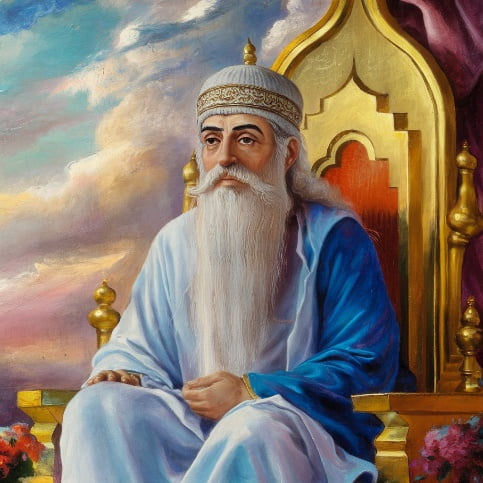

AI-assisted visualization
In general there are many religions practiced around the world, each with its own beliefs, rituals and cultural significance. Here are some of the world's major religions:
1. Christianity: Christianity is a monotheistic religion based on the life, teachings, death and resurrection of Christ. It is the largest religion in the world, with over two billion believers. Christians believe in the Holy Trinity – God the Father, Son (Jesus Messiah) and the Holy Spirit. The Bible serves as the sacred text, and Christian worship often includes congregational gatherings for prayer, sacraments (rituals such as baptism), and the singing of hymns.
2. Islam: Islam is a monotheistic religion founded by the Prophet Muhammad in the 7th century AD in the Arabian Peninsula. It is the second largest religion in the world, with over 1.9 billion believers. Muslims adhere to the five pillars of Islam, which include faith, prayer, fasting, charity and the pilgrimage to Mecca (Hajj). The Koran is the holy book of Islam, containing revelations that Muhammad received from Allah (God).
3. Hinduism: Hinduism is one of the oldest religions in the world, originating in ancient India. It is characterized by diverse beliefs, rituals and philosophies, with no single founder or central authority. Hinduism encompasses various gods and goddesses, such as Brahma, Vishnu, Shiva and Devi, and emphasizes concepts such as dharma (duty), karma (action and its consequences) and reincarnation. The Vedas, the Upanishads, the Bhagavad Gita and the Ramayana are among the sacred texts of Hinduism.
4. Buddhism: Buddhism was founded by Siddhartha Gautama, also known as the Buddha, in ancient India around the 6th century BC. It is a non-theistic religion that focuses on spiritual enlightenment and liberation from suffering through the practice of mindfulness, meditation and ethical behavior. Buddhists follow four The Noble Truths and the Eightfold Path [described by Gautama Buddha as the path leading to the end of suffering (dukkha) and enlightenment] as guiding principles.The Tripitaka (Pali Canon) and the Mahayana Sutras are important Buddhist scriptures.
5. Judaism: Judaism is one of the oldest monotheistic religions, and has its origins in the covenant between God and our forefather Abraham in ancient Israel. It is characterized by adherence to the Torah, the central religious text containing laws, teachings and narratives. Jewish worship includes prayers, rituals and observance of religious holidays such as Passover, Yom Kippur and Hanukkah. Judaism includes various branches, including Orthodox, Conservative, Reform, and Reconstructionist.
6. Sikhism: Sikhism arose in the Punjab region of South Asia in the 15th century AD, founded by Guru Nanak and developed by the Sikh Gurus who followed him. It is a monotheistic religion that emphasizes the worship of the One God (Wahaguru) and the principles of equality, service to the community and devotion. The Guru Granth Sahib, a scripture containing hymns and teachings, serves as the eternal guru of the Sikhs.
These are just a few examples of the variety of religions practiced around the world. Other significant religions include Jainism, Taoism, Shintoism, the Baha'i faith, and indigenous spiritual traditions. Each religion has its own unique beliefs, practices and cultural significance, which contribute to the rich fabric of human spirituality and worldview.
In general, it is important to clarify that the religions themselves are not inherently militant. However, individuals or groups may interpret religious teachings in ways that justify or inspire militant or violent behavior. Here are some examples of groups or movements associated with militancy or violence that used religion as justification or motivation:
1. Islamic Extremism: Various extremist groups, such as ISIS (Islamic State of Iraq and Syria), Al-Qaeda and Boko Haram, have used a distorted interpretation of Islam to justify acts of terrorism, insurgency and violence. They often cite religious texts and religious beliefs to legitimize their actions, although their interpretation is widely rejected by most Muslims around the world.
2. Christian extremism: Although uncommon compared to Islamic extremism, there have been cases of extremist Christian groups or individuals resorting to violence, especially in the context of anti-abortion extremism or white supremacy movements. The use of violence by such groups is often condemned by mainstream Christians.
3. Hindu nationalism: In India there are national movements such as Hindutva, which advocate the promotion of Hindu culture and values. Some extremist elements within these movements have been linked to acts of violence against religious minorities, especially Muslims and Christians.
4. Buddhist Militancy: While Buddhism is generally associated with non-violence and pacifism, there have been cases of Buddhist nationalist movements in countries such as Myanmar and Sri Lanka using violence against minority groups, particularly Muslims.
5. Jewish extremism: There are certain extremist factions even in small parts of the Jewish population, especially in Israel, that engage in acts of violence.
It is important to recognize that the actions of militant groups or individuals do not represent the beliefs or values of the entire religious community.
The vast majority of religious believers around the world reject violence and extremism, and many religious traditions promote peace, compassion and social justice. In addition, political, economic and social factors often play a significant role in driving militant behavior, alongside religious motivations.

AI-assisted visualization
Social scientists and researchers studying interfaith conflicts use various theoretical and methodological frameworks to analyze and predict outcomes. Some of the approaches and concepts they use include:
1. Social identity theory: This theory, developed among others by the psychologists Henri Tajpel and John Turner, assumes that individuals derive a sense of self and belonging from their membership in social groups, including religious communities. Social psychologists study how intergroup dynamics, such as competition, prejudice, and discrimination, can lead to conflict between religious groups.
2. Models for conflict resolution: Researchers in the field of conflict resolution develop models and strategies for managing and resolving conflicts between religions.
These models may include techniques such as negotiation, mediation, dialogue and reconciliation, which aim to address underlying grievances and foster mutual understanding and cooperation.
3. Resource conflict theory: Resource conflict theory examines how competition for scarce resources, such as land, water or economic opportunities, can contribute to conflicts between religious groups. Social scientists analyze how religious identities and narratives intersect with material interests and resource distribution, leading to tensions and disputes.
4. Security threat theory: Political science and international relations researchers use security threat theory to understand how conflicts between religions are framed as security threats by political actors and institutions. This approach examines how issues related to religion, such as extremism, terrorism and religious nationalism, are mobilized for political purposes, often exacerbating tensions and violence.
5. Ethnographic studies: Anthropologists and sociologists conduct ethnographic studies to gain insight into the lived experiences and perspectives of individuals and communities involved in religious conflicts. Through participant observation, interviews and analysis of cultural practices, researchers seek to understand the underlying causes of conflicts and the factors that contribute to escalation or resolution.
6. Game theory: Game theory provides a mathematical framework for analyzing strategic interactions between players with conflicting interests. Researchers apply game theory to investigate how religious groups make decisions in contexts of conflict, cooperation, and competition, taking into account factors such as risk, trust, and the influence of external actors.
7. Historical Analysis: Historians examine past conflicts between religions to identify patterns, causes, and outcomes, and provide insights into the dynamics of contemporary religious conflicts. By contextualizing contemporary events within broader historical narratives, researchers can identify recurring themes and trajectories and assess the potential for resolution or escalation.
In general, predicting the outcome of interfaith conflicts is challenging due to the complexity of the factors involved, including religious beliefs, political dynamics, socioeconomic conditions, and historical legacies.
Researchers draw on interdisciplinary approaches and empirical evidence to develop nuanced understandings of these conflicts and inform efforts to mitigate their impact and promote peacebuilding.
Researchers in the field include:
Samuel F. Huntington: Huntington, a political scientist, is best known for his influential book The Clash of Civilizations and the Reshaping of the World Order (1996). In this work he claims that future conflicts will be driven mainly by cultural and religious differences and not by ideological or economic factors, which will lead to clashes between cultures. Although controversial, Huntington's thesis has sparked extensive discussion and research on the role of religion in world politics.
Karen Armstrong: A former nun turned historian of religion, Armstrong has written extensively on the history and philosophy of the various world religions. Her works, such as The Battle for God (2000) and Fields of Blood: Religion and the History of Violence (2014), examine the complex relationship between religion, violence and conflict. Armstrong emphasizes the importance of understanding religious traditions in their historical and cultural context in order to address religious conflicts effectively.
Scott Atran: A cognitive anthropologist, Atran's research focuses on the psychology of religious belief and extremism. His work examines the social and cognitive mechanisms underlying religious violence and terrorism, emphasizing the role of group identity, sacred values and moral feelings in shaping behavior. Atran's research contributes to the understanding of the motivations and ideologies that drive individuals and groups engaged in religious conflicts.
Jonathan Fox: Fox is a political scientist known for his research on religion and conflict, particularly in the context of religion-state relations and religious freedom. His book "Political Secularism, Religion and the State: A Time Series Analysis of Global Data" (2015) analyzes patterns of religious discrimination and violence between countries, highlighting the complex interrelationships between religion, politics and human rights.
Oliver F. Richmond: A peace and conflict scholar, Richmond studies the dynamics of conflict resolution and peacebuilding in divided societies, including those marked by religious tensions. His work emphasizes the importance of inclusive dialogue, reconciliation and addressing the roots of conflict, such as socio-economic inequality and historical hardships. Richmond's concepts of "liberal peace" and "post-liberal peace" offer frameworks for understanding and handling religious conflicts in contemporary contexts.
Marc Goffin: A theologian and conflict resolution expert, Goffin focuses on the intersection of religion and conflict transformation. His work emphasizes the role of religious leaders, institutions and traditions in promoting peace and reconciliation, while relying on case studies from different religious traditions and conflict zones. Goffin's concept of "sacred peacemaking" emphasizes the potential of religious beliefs and practices to contribute positively to conflict resolution efforts.
Samuel P. Huntington:
◦ "The Clash of Civilizations and the Remaking of World Order" (1996)
Karen Armstrong:
- "The Battle for God: A History of Fundamentalism" (2000)
- "Fields of Blood: Religion and the History of Violence" (2014)
Scott Atran:
- "In Gods We Trust: The Evolutionary Landscape of Religion" (2002)
- "Talking to the Enemy: Faith, Brotherhood, and the (Un)Making of Terrorists" (2010)
Jonathan Fox:
- "Political Secularism, Religion, and the State: A Time Series Analysis of Worldwide Data" (2015)
- "Religious Discrimination and Violence: An International Comparative Study" (2008)
Oliver P. Richmond:
- "A Post-Liberal Peace" (2011)
- "The Transformation of Peace" (2008)
Marc Gopin:
- "Between Eden and Armageddon: The Future of World Religions, Violence, and Peacemaking" (2000)
- "Holy War, Holy Peace: How Religion Can Bring Peace to the Middle East" (2002)
These scholars represent a wide range of perspectives and methodologies in the study of religious conflict, offering valuable insights into the causes, dynamics, and potential solutions of conflicts shaped by religious differences.
As mentioned, we assume that a person's social self consists of the internalization of influential people throughout his life and these are represented in what we called the management of internalized characters that build this social self. Such a manager is hierarchical and headed by a very influential figure or figures that we metaphorically called the dictator-self or selves [see previous conversations], the question arises as to what happens to the social self of a religious believing person:
The social self of a religious person can be complex and multifaceted, influenced by various factors including family, community, religious leaders, heroes of religious texts and the god or gods.
Below we list the effects:
Family Influence: At a basic level, the social self of a religious person may be greatly influenced by their family. From a young age the person may be exposed to customs, rituals and religious teachings within his family environment. This can include participating in religious ceremonies, participating in religious holidays and learning moral and ethical values related to their faith from their parents or guardians.
Community influence: beyond the family, the social self of the religious person is shaped by the wider religious community to which he belongs. This community may include fellow worshipers, religious leaders, and other friends who share similar beliefs and values. Interactions within this community strengthen and deepen the individual's sense of identity and belonging to his religious tradition.
Religious leaders and teachers: Within the hierarchical order, religious leaders and teachers have a significant influence on the social self of a religious person. These figures may include clergy, scholars, or spiritual guides who provide guidance, interpretation of religious texts, and moral guidance. Their teachings and personal example serve as a role model for the individual.
The Holy Scriptures and the religious texts: Central to the social self of a religious person are the Holy Scriptures and the religious texts related to his faith tradition through the representation of their heroes and the figure of God and through the conceptual personification. These texts serve as primary sources of wisdom, moral guidance, and theological understanding. Through the study, observation and interpretation of these texts, man internalizes the beliefs, values and principles that shape his religious identity. As mentioned, among other things, these rituals are internalized through the figures who wrote or interpreted them.
Personal spiritual experiences: In addition, the social self of a religious person may be influenced by personal spiritual experiences, such as moments of prayer, meditation or divine revelation. These subjective experiences can deepen a person's connection to his faith and contribute to his sense of identity as a religious person. These experiences are internalized through the figures associated with spiritual experiences to him as the figure of God and more.
In summary, the social self of a religious person is composed of internalized influences from various sources arranged in a hierarchical order, including family, community, religious leaders, scriptures, and personal spiritual experiences. These influences collectively shape an individual's beliefs, values, customs and sense of identity within their religious tradition.
The hierarchy of internalization within the social self of a religious person can be conceptualized as a pyramid, with fundamental influences at the base and more abstract or personal influences at the apex. Here is an example breakdown of such a hierarchy:
1. Family and immediate community: At the base of the hierarchy will be the influences from the family and the immediate community. These include parents, siblings, extended family members and close friends who share the same religious beliefs and practices. From a young age, the religious person is immersed in the rituals, traditions and teachings of his family and community, and constitutes the fundamental layer of his religious identity.
2. Religious community and leaders: The next level in the hierarchy includes the wider religious community and its leaders. This includes participating in religious communities, participating in prayers, and engaging in community rituals and customs. Religious leaders such as clergy, spiritual guides and educators play a significant role in shaping an individual's understanding of their faith and providing moral and ethical guidance.
3. Religious texts and teachings: higher up the hierarchy, we encounter the influence of religious texts and teachings through the figures that represent them. But the books or the holy book can also be personified and internalized. These scriptures, scriptures, and doctrinal writings serve as authoritative sources of guidance and wisdom within the religious tradition. Through the study, observation and interpretation of these texts, man internalizes the beliefs, values and principles that form the core of his religious identity.
4. Personal spiritual experiences: near the top of the hierarchy are personal spiritual experiences. These subjective encounters with the divine, such as moments of prayer, meditation or mystical insight, deepen a person's connection to his faith and contribute to his personal sense of spirituality. The divine and its representations are personified and internalized. While these experiences are highly personal and subjective, they often serve to strengthen and deepen an individual's commitment to their religious beliefs and practices.
5. Integration and synthesis: It is possible that at the top of the hierarchy as a dictator-self, a schematic figure is built that expresses the integration and synthesis of all these internalizations. The individual's social self is characterized by a cohesive and integrated religious identity that reflects a harmonious fusion of family, community, textual and experiential influences. This integrated identity shapes the individual's worldview, values, behaviors and sense of vocation in the context of his religious tradition.
In conclusion, the hierarchy of internalizations within the social self of the religious person progresses from fundamental influences at the base, including family and community, to more abstract and personal influences at the peak, such as personal spiritual experiences and the integration of various sources of authority and religious guidance.
We will now move on to the question of why humans often perceive the image of God as a man?
The perception of God as a human figure can be attributed to various factors, including cultural, psychological and historical influences:
1. Anthropomorphism: Humans tend to anthropomorphize, or attribute human traits to non-human beings. This tendency may lead people to imagine God in human terms.
2. Religious texts and traditions: Many religious texts describe God in anthropomorphic ways, using human characteristics such as feelings, intentions, and actions to describe the divine. These descriptions can affect how believers perceive and attain God.
3. Emotional and psychological comfort: Imagining God as a person can provide a sense of familiarity, comfort, and relational connection. People may find it easier to relate to a human-like deity because it allows for a more personal and intimate relationship.
4. Cultural influences: Cultural depictions of God as a human-like figure, such as paintings, sculptures, and literature, can shape individuals' perception of the divine. These representations often reflect the prevailing cultural norms and values in society.
5. Interpersonal relationships: Human relationships serve as a primary frame of reference for understanding concepts such as love, authority, and guidance. As a result, humans may project these relational dynamics onto their conception of God, imagining a figure who embodies these qualities in a human-like form.
6. Limitations of Human Understanding: The human mind often relies on familiar frameworks and analogies to understand abstract concepts. In their attempt to understand the infinite and indescribable nature of God, people may use anthropomorphic imagery as a cognitive tool to grasp the incomprehensible.
Below are a variety of examples of how different religions perceive God in a human-like form:
Christianity: In Christianity, God is often depicted as a father figure, with references to God the Father, who is believed to have human qualities such as love, mercy and compassion. In addition, the belief in the incarnation of Jesus Messiah as the Son of God emphasizes the human aspect of God.
Islam: In Islam, God is seen as having anthropomorphic qualities such as hearing, seeing and speaking. Although Islam strongly rejects any description of God in a physical form, the Qur'an describes Allah in terms that evoke human qualities, such as mercy, justice and guidance.
Judaism: In Judaism, God is often described in anthropomorphic terms in the Bible (the Bible), such as hands, eyes, and voice. However, Jewish theology emphasizes God's transcendence and incomprehensibility, and cautions against literal interpretations of anthropomorphic descriptions.
Hinduism: In Hinduism, there are many gods and goddesses depicted in human-like forms, such as Brahma, Vishnu, Shiva and Devi. These deities are often depicted with human qualities, emotions, and relationships, reflecting the belief in a divine presence that can manifest in various forms.
Buddhism: While Buddhism does not generally conceive of a creator deity in the same way as other religions, some Buddhist traditions incorporate anthropomorphic representations of deities, such as Buddhas and bodhisattvas, depicted with human qualities of wisdom, compassion, and enlightenment.
Sikhism: In Sikhism, God is often referred to as "Waheguru", meaning "wonderfully enlightened". While Sikh theology emphasizes the formlessness and transcendence of God, the Guru scripture Granth Sahib contains anthropomorphic descriptions of Wahaguru's attributes and actions.
Shintoism: In Shintoism, Japan's indigenous religion, kami (spirits or gods) are often depicted in human-like forms, such as ancestors, heroes, or natural phenomena. These anthropomorphic representations reflect the belief in a divine presence that permeates the natural world.
Ancient Egyptian Religion: In the ancient Egyptian religion, the gods and goddesses were depicted in human-like forms with animal heads or other symbolic features. For example, Re, the sun god, was often depicted with a human body and the head of a falcon.
Greek Mythology: In Greek mythology, gods and goddesses were described as anthropomorphic beings with human-like appearance, personality and emotions. For example, Zeus, the king of the gods, was often depicted as a powerful, bearded man wielding lightning bolts.
Norse Mythology: Similarly, in Norse mythology, the gods and goddesses were depicted as human figures with different personalities and attributes. Odin, the chief god, was often depicted as an elderly man with a long beard and a wide-brimmed hat.
Native American Religions: Many Native American religions feature anthropomorphic depictions of spiritual beings, such as gods, spirits, and tricksters, who are often depicted with human-like features and characteristics.
Traditional African Religions: In various traditional African religions, gods, ancestors, and spirits are often depicted in human-like forms, reflecting the belief in a divine presence that interacts with and influences human affairs.
Zoroastrianism: In Zoroastrianism, the ancient religion of Persia, Ahura Mazda is the supreme deity often depicted in human form, embodying qualities such as wisdom, justice and goodness.
Indigenous Australian religions: In Indigenous Australian religions, ancient beings known as Dreamtime Ancestors are often depicted in humanoid forms and believed to have shaped the landscape and provided laws and traditions to human communities.
Taoism: While Taoism emphasizes the formless and indescribable nature of the Tao (the fundamental principle of the universe), Taoist mythology includes anthropomorphic representations of deities, immortals, and celestial beings with human-like attributes and powers.
In order to get an idea of the studies being conducted in connection with the images of God, below are some summaries of several studies in connection with the images of God as it appears from a review from various sources, mainly from PUBMED.
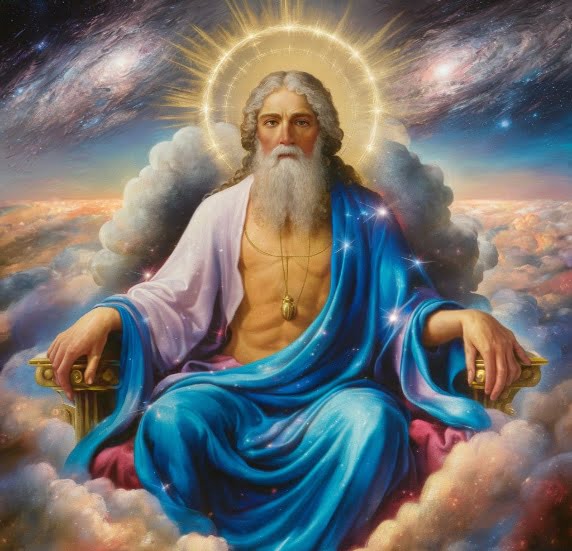
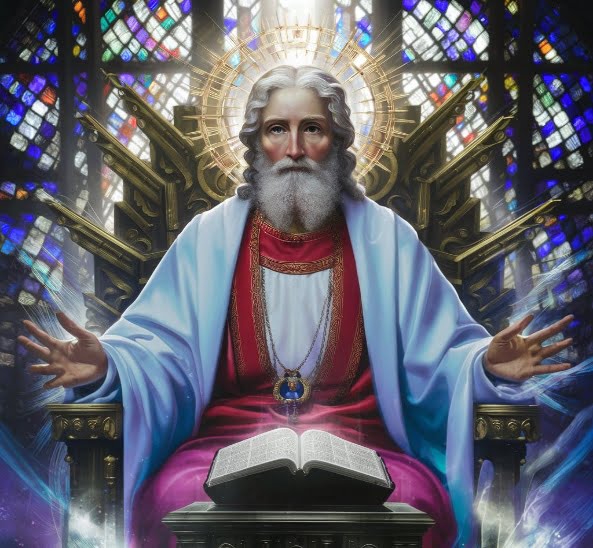
AI-assisted visualization
The sources of these summaries are:
Int J Psychol Relig. 2010;20(2):130-147 .Attachment to God, Images of God, and Psychological Distress in a Nationwide Sample of Presbyterians. Matt Bradshaw , Christopher G Ellison, Jack P Marcum
Proc Natl Acad Sci U S A. 2009 Mar 24;106(12):4876-81. Cognitive and neural foundations of religious belief. Dimitrios Kapogiannis , Aron K Barbey, Michael Su, Giovanna Zamboni, Frank Krueger, Jordan Grafman
Dev Psychol. 2008 Nov;44(6):1753-1763. Attachment and God representations among lay Catholics, priests, and religious: a matched comparison study based on the Adult Attachment Interview. Rosalinda Cassibba , Pehr Granqvist , Alessandro Costantini , Sergio Gatto
J Am Acad Psychoanal Dyn Psychiatry. 2009 Spring;37(1):219-39. Discussion of a symposium: the God representation in the psychoanalytic relationship: When is three a crowd? Moshe Halevi Spero , Mariam Cohen
J Am Acad Psychoanal Dyn Psychiatr. 2009 Spring;37(1):1-19. Introduction to a Symposium: the God Representation in the Psychoanalytic Relationship: When is Three a Crowd? Moshe Halevi Spero , Mariam Cohen
Case Reports Burns 1999 Aug;25(5):443-8. Images of God used by self-injurious burn patients. D H Grossoehme , L S Springer
J Am Acad Psychoanal Dyn Psychiatry 2009 Spring;37(1):85-98. The role of religious imagery in adaptive psychotherapy. Robert Langs
Prayer, God Imagery, and Symptoms of Psychopathology Matt Brandshaw et al. Journal for the Scientific Study of Religion First published: 04 November 2008
Relationship between pathological guilt and god image with depression in cancer patients. Seyedeh Zahra Alavi a, et al.
And below are the summaries:
A] Attachment to God, Images of God, and Psychological Distress in a Nationwide Sample of Presbyterians. Matt Bradshaw , Christopher G Ellison, Jack P Marcum
Summary
The present study draws broadly on insights from attachment theory, and outlines a series of theoretical arguments linking styles of attachment to God, perceptions of God's nature (ie, God images), and stressful life events with psychological distress. The main effects and potential effects of stress mitigation are then assessed using data from a national sample of seniors and lay members of the Presbyterian Church (USA).
Key findings indicate that secure attachment to God is inversely related to distress, while both anxious attachment to God and stressful life events are positively related to distress. Once one statistically controls [actually takes out of the account] the variations of the patterns of attachment to God, there are no net effects of the image of God on levels of distress.
In the study itself, there is only modest support for the hypothesis that images of God moderate the effects of stressful life events on psychological distress, but no stress-moderating effects on attachment to God were found. Limitations of the study are identified, and the findings are discussed in terms of their implications for religious health research, as well as recent extensions of attachment theory.
B] Cognitive and neural foundations of religious belief. Dimitrios Kapogiannis , Aron K Barbey, Michael Su, Giovanna Zamboni, Frank Krueger, Jordan Grafman
Summary
We propose an integrative cognitive neuroscience framework for understanding the cognitive and neural foundations of religious belief. Our analysis reveals 3 psychological dimensions of religious belief (perceived level of involvement of God, perceived emotion of God, and doctrinal/experiential religious knowledge), a functional MRI study places these dimensions within processing networks of the "THEORY OF MIND" [ MIND] regarding intention and emotion, abstract semantics and imagery. Our results are unique in that they show that specific components of religious belief are mediated by known brain networks, and support current psychological theories that ground religious belief within evolutionary adaptive cognitive functions.
C] Attachment and God representations among lay Catholics, priests, and religious: a matched comparison study based on the Adult Attachment Interview. Rosalinda Cassibba , Pehr Granqvist , Alessandro Costantini , Sergio Gatto
Summary
Based on the idea that believers' perceived relationships with God develop from experiences related to their engagement with primary caregivers [father, mother, etc.], the authors examined the quality of such experiences and their representation among people who differed in the likelihood of experiencing a primary relationship with God. Using the Adult Attachment Interview, they compared attachment-related experiences and representations in a group of 30 Catholic priests and religious with a matched group of lay Catholics and with the global normal distribution of Adult Attachment Interview classifications.
They found an overrepresentation of attachment-autonomy-secure states among those who were more likely to experience a primary attachment to God (ie, priests and religious) compared to the other groups, and an underrepresentation of unresolved-disorganized states of attachment in both groups of Catholics compared to the global normal distribution . The main findings also included a relationship between secure-autonomous states regarding attachment and perceived experiences with loving or non-rejecting parents on the one hand, and loving God images on the other. These results extend the literature on religion from an attachment perspective and support the idea that general working models derived from attachment experiences with parents are reflected in beliefs about God.
D] Discussion of a symposium: the God representation in the psychoanalytic relationship: When is three a crowd? Moshe Halevi Spero , Mariam Cohen
Summary
A discussion is offered of some of the main trends and unique ideas that can be distinguished among the 14 articles presented in the symposium dedicated to the role of religious images, and in particular representations of God or divinity, in the psychoanalytic process. The symposium focused on the beliefs and images of the analyst as well as of the analyst, based on the view that an image or concept identified as "God" is probably an inevitable component of the development of human representational consciousness and its limits, regardless of anything else that this image may point to, theologically speaking. The authors were asked to use clinical material to address the hypothesis that the dynamic roots and potential of such representations would be reflected in countertransference [as the therapist's unconscious responses to the patient] to the extent that such representations are involved in the conflicts and deeper forms of mental restlessness that bring the individual to treatment. In this paper, the symposium editors discuss the extent to which authors have approached this type of understanding, acceptance, challenge, or simply deviation from recognition of it.

AI-assisted visualization
E] Introduction to a Symposium: the God Representation in the Psychoanalytic Relationship: When is Three a Crowd? Moshe Halevi Spero , Mariam Cohen
Summary
The symposium has an introduction that discusses how the representation of God's image can affect the dialogue and the analytic process, focusing on the beliefs and images of the analyst as well as the person undergoing analysis. If, as the theory suggests, an image or concept identified as "God" is an inevitable element in the development of the human mind (whatever the theological meaning of this image may be), then it seems that the dynamic roots and potential of this type of representation will find some expression in the countertransference dimension of the the analytical work.
Contributors to the symposium were asked to offer detailed clinical material, paying particular attention to their own countertransference experiences to focus on the influence of religious imagery on their "religiously oriented" internal experiences. Three questions were posed in order to conceptualize the clinical transaction in ways that could clarify our research interests. The authors did not assume that the authors of the symposium, or the commentators in general, were officially religious, nor was this necessary for the task. Most of the 14 authors identified themselves as religious today; 4 identified in some indirect way to one degree or another. Interestingly, the intensity of engagement in countertransference at the level of personal religious experience varied across the group.
F] Images of God used by self-injurious burn patients. D H Grossoehme , L S Springer
Summary
Suicide by burning and other forms of self-injurious behavior involving burning are sometimes considered to have religious overtones. The ritual death of widows at their husbands' funerals is closely related to Hindu beliefs. Buddhists used self-immolation as a form of protest. In the Judeo-Christian traditions there are images of fire as a purifier; There are also secular images that associate fire with images of condemnation and evil. Previous studies have described religiosity as a common theme among survivors. The present study describes the ways in which people who have engaged in self-injurious behaviors through burning, including suicide attempts, visualize the divine and use religious language to give meaning to their experience.
G] The role of religious imagery in adaptive psychotherapy. Robert Langs
Summary
This article presents the perspective of the approach in adaptive psychotherapy in relation to overt allusions to images of God and other religious themes from patients in psychotherapy and psychoanalysis. Such images are understood and interpreted equally to secular images, as reflections of deeply encoded unconscious experiences, many of them in response to the interventions of therapists. The article also examines the reasons why religious imagery is not common in adaptive therapies, discusses evidence that therapists' religious self-disclosures and their extended personal responses to patients' religious imagery are maladaptively based on countertransference, and suggests that certain types of coded non-religious imagery suggest that thinking On the deep subconscious as an inner god with divine wisdom and pure morality. Deciding whether this view speaks for the existence of a transcendental deity or is properly considered in secular terms lies beyond the realm of psychoanalytic observation and thinking.
H] Prayer, God Imagery, and Symptoms of Psychopathology Matt Brandshaw et al.
Summary
Researchers have shown interest for many years in the connection between religion and mental health. In this article we describe a series of hypotheses linking personal prayer, images of God and mental health. We then empirically test the hypotheses using data from an online survey of US adults (N = 1,629) conducted in 2004 by Spirituality and Health magazine. We find a positive relationship between frequency of prayer and the perception of God as distant and between several different forms of psychopathology; A perceived intimate relationship with a loving God is inversely related to prayer.
The positive relationship between prayer and psychopathology is mainly expressed among people who experience God as distant or (b) unloving. We also find an inverse correlation between prayer and psychopathology among people who believe they pray to a near God (the opposite of distant). We discuss the implications of these findings for research on the relationship between religion and mental health and outline an agenda for future research.
I] Relationship between pathological guilt and god image with depression in cancer patients. Seyedeh Zahra Alavi a, et al.
Summary
The aim of the study was to investigate the relationship between pathological guilt and the image of God and depression among cancer patients. The participants were 100 cancer patients (50 women and 50 men) selected by sampling and answered three questionnaires: the Pathological Guilt Questionnaire (PGQ), the Beck Depression Questionnaire (BDI) and the God Images Questionnaire (GII). The results of the regression analysis showed that there is a clear relationship between depression and pathological guilt and also between the image of God and depression. Furthermore, the results of the regression analysis showed that pathological guilt has a significant role in predicting depression.
We will now return to the concept of religion in relation to the directorate of internalized characters:
The life of prehistoric man was full of dangers: harmful natural events, predators, diseases, attacks from other tribes could threaten his survival
at any given moment. The threatening death of relatives and other members of the tribe was also another existential difficulty that had to be overcome.
Something had to be invented to somehow alleviate the persistent feeling of uncertainty and lack of control over so many events in daily life.
The solution was the invention or the development of a belief system or religion. It is feasible that no religious or spiritual message could be expressed in human society before the creation of an enough developed language
as the tool that could enable the transfer of such content. It is assumed that the tribal shaman could have been the first agent to deliver such a message.
For the first time in human history, an idea developed that apart from the physical world that can be perceived through our bodily senses, there is another, secret world, which is not visible that contains not less but sometimes even greater meaning than the real world. Thus, familiar objects such as animals, natural events,
and physical entities could have a hidden pan and so for the first time, a completely new kind of world, a hidden virtual world penetrated human consciousness.
It was this world of spirits that promised to a prehistoric man much more power and control over the world than ever before.
The shaman presented himself as a mediator that could communicate with these spirits thus providing prehistoric man with a much better sense of control over the events of his life. These inhabitants of the virtual world have achieved their coveted place in our minds through their representations in the internalized characters' directory, characters with a fairly high place in the internal hierarchy that have become our imaginary companions.
The next stage as mentioned was the development of polytheistic beliefs. This time the supernatural beings, called gods, often resembled humans, but they had far greater power over people's lives than humans could ever have. In Greek mythology, they could even mate
with humans that resulted in creating demigods. These gods had a hierarchy among themselves, man himself could have his own preferences, could choose
some gods over others.
These gods were internalized as imaginary figures with a specific hierarchy that depended on the person's preferences in managing his internalized figures. They could have a higher hierarchy in managing the internalized figures than the internalized figures of the significant people or groups that had an external representation depending on the strength of the person's belief.
The more contemporary step was to reduce the number of gods, which finally led to a single god. The first known religion that spoke of a single god was the religion of ancient Egypt [Re, one of the earliest gods in the ancient Egyptian pantheon, back in the days of the Lower Kingdom, where he served as the sun god and the protector of the kingdom's capital, was selected for this purpose by Pharaoh Akhenaten, formerly Amenhotep IV]. The short reign of this first recorded monotheist brought about a theological, political and artistic revolution, and reverberates throughout history.
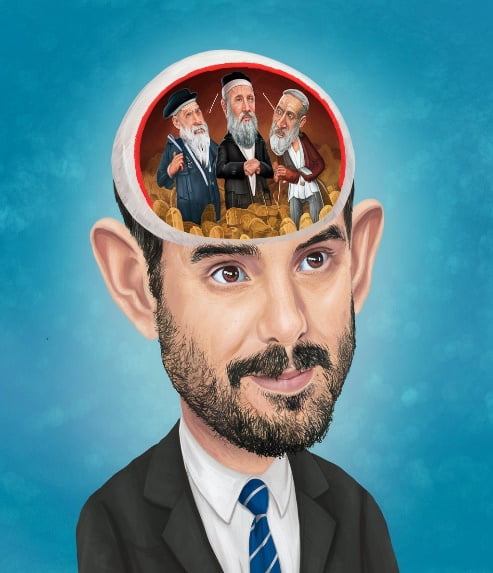
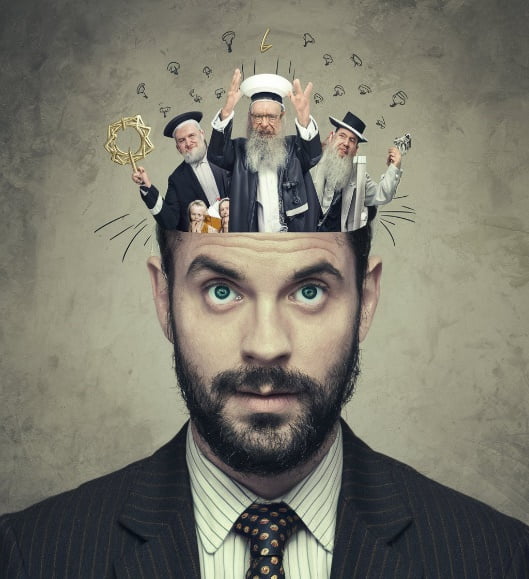
AI-assisted visualization
The monotheistic religion developed in the Middle East by the Jews created a completely different type of God that in the ideal he had nothing in common with humans, he was indescribable, he was omnipotent, represented everywhere and at all times, and had complete control over our existence. Moreover, God was also the sole creator of the universe in all its forms.
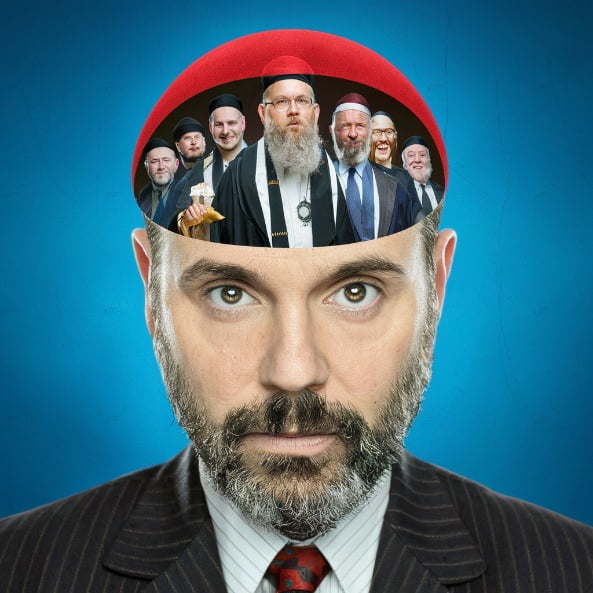
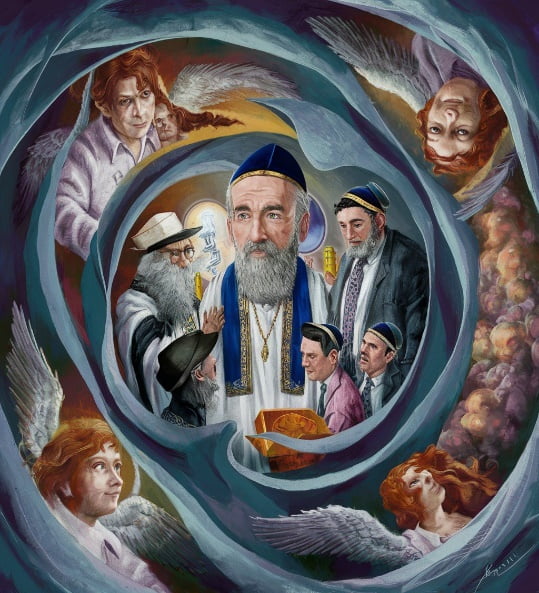
AI-assisted visualization
The internal representation of the figure of God (this is of course an imaginary figure) in the management of internalized figures and its position in the internal hierarchy, depends greatly on the strength of the person's faith. The "interpreters" of God's intentions, who are usually the clergy, also play a higher role in the inner hierarchy of the management of internalized figures. Thus the Pope is even declared to be God's representative on earth. We will also add that the internal interaction between the main players within the board of internalized figures also depends on the structure of the state (dictatorial, democratic, theocratic, etc.), on the dominance of figures from the person's family and groups, on the degree of isolation of the specific group to which the person belongs from other groups (such as in certain cults), and more.
That's it for now,
yours,
Dr. Igor Salganik and Prof. Joseph Levine
 Prof. Joseph Levine, M.D. is an emeritus associate professor in the Division of Psychiatry, Faculty of Health Sciences, Ben Gurion University in Israel. Prof. Levine is a certified psychiatrist with clinical experience in controlled trials of adult psychiatric disorders and in psychotherapy. He was awarded a NRSAD independent investigator grant for the study of Creatine Monohydrate in psychiatric disorders -- mainly Schizophrenia. He resides and treats patients in Tel Aviv and all of central Israel.
Prof. Joseph Levine, M.D. is an emeritus associate professor in the Division of Psychiatry, Faculty of Health Sciences, Ben Gurion University in Israel. Prof. Levine is a certified psychiatrist with clinical experience in controlled trials of adult psychiatric disorders and in psychotherapy. He was awarded a NRSAD independent investigator grant for the study of Creatine Monohydrate in psychiatric disorders -- mainly Schizophrenia. He resides and treats patients in Tel Aviv and all of central Israel.
Leave a comment